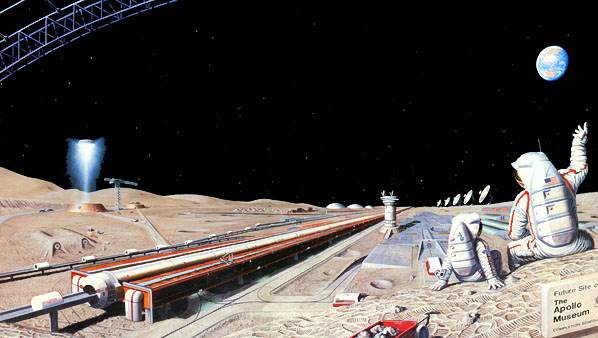
This painting by Pat Rawlings depicts a lunar mass driver (courtesy Lunar and Planetary Institute)
- NSS KOKH LUNAR LIBRARY
- Is a Domed Lunar City Possible?
- Viral Architecture for Lunar Settlements
- Recommended Reading
- Links
Excerpt from speech of John Marburger
Director, Office of Science and Technology Policy, Executive Office of the President, March 15, 2006
The Moon has unique significance for all space applications for a reason that to my amazement is hardly ever discussed in popular accounts of space policy. The Moon is the closest source of material that lies far up Earth’s gravity well. Anything that can be made from Lunar material at costs comparable to Earth manufacture has an enormous overall cost advantage compared with objects lifted from Earth’s surface. The greatest value of the Moon lies neither in science nor in exploration, but in its material. I am talking about the possibility of extracting elements and minerals that can be processed into fuel or massive components of space apparatus. The production of oxygen in particular, the major component (by mass) of chemical rocket fuel, is potentially an important Lunar industry.
What are the preconditions for such an industry? That, it seems to me, must be a primary consideration of the long range planning for the Lunar agenda. Science studies provide the foundation for a materials production roadmap. Clever ideas have been advanced for the phased construction of electrical power sources – perhaps using solar cells manufactured in situ from Lunar soil. A not unreasonable scenario is a phase of highly subsidized capital construction followed by market-driven industrial activity to provide Lunar products such as oxygen refueling services for commercially valuable Earth-orbiting apparatus.

image: Leap of Faith Lunar Stadium by Pat Rawlings
Low lunar gravity allows new kinds of sports. Painting by Pat Rawlings courtesy NASA.
Annotated Bibliography of Recommended Reading
2016: The Value of the Moon. Paul D. Spudis. 272 pages. [NSS Review]. [Amazon Link
2010: Lunar Settlements. Edited by Haym Benaroya. 804 pages. [NSS Review]. [Amazon Link
2007: The Moon: Resources, Future Development, and Settlement, Second Edition. David Schrunk, Burton Sharpe, Bonnie Cooper, and Madhu Thangavelu. Springer Praxis Books. 608 pages. [NSS Review]. [Amazon link
2006: The Lunar Base Handbook: An Introduction to Lunar Base Design, Development, and Operations, 2nd Edition. Peter Eckart. McGraw-Hill. 860 pages. [Where to buy]. A good technical treatment of all aspects of building a lunar base. Written primarily for engineers but the clear writing is quite accessible for interested laymen. Forget about Amazon for this one — our link is the only place you can get the second edition of this excellent resource.
2006: Return to the Moon: Exploration, Enterprise, and Energy in the Human Settlement of Space. Harrison H. Schmitt. Praxis Publishing. 336 pages. [NSS Review]. [Amazon link
2005: Return to the Moon. Edited by Rick Tumlinson and Erin Medlicott. Apogee Books. 208 pages. [Amazon link
2004: Moonrush: Improving Life on Earth with the Moon’s Resources. Dennis Wingo. Apogee Books. 260 pages. [NSS Review]. [Amazon link
1991: The Lunar Sourcebook: A User’s Guide to the Moon. G. H. Heiken, D. T. Vaniman, and B. M. French, editors. Cambridge University Press. 756 pages. Free online HTML version and PDF available. The only work to date to collect data gathered during the American and Soviet missions in an accessible and complete one-volume, encyclopedic reference of scientific and technical information about the Moon. Primarily for scientists but is also quite accessible for the interested layman.
Return to the Moon Studies
- First Lunar Outpost (FLO) 1992
- LUNOX 1993
- Early Lunar Access (ELA) 1993
- LANTR and LUNOX 1994
- Human Lunar Return (HLR) 1996
- Constellation 2005
Links
- NASA Why the Moon? poster [PDF 2.1 MB]
- Google Lunar X Prize video (8 minutes)
- Spudis Lunar Resources
- International Lunar Resource Park
- International Lunar Exploration Working Group (ILEWG)
- Lunar Solar Power System for Energy Prosperity within the 21st Century by David Criswell [PDF 285K]
- Building a Base on the Moon
- Gaia Selene: Saving the Earth by Colonizing the Moon [DVD]
- The Moon Society







